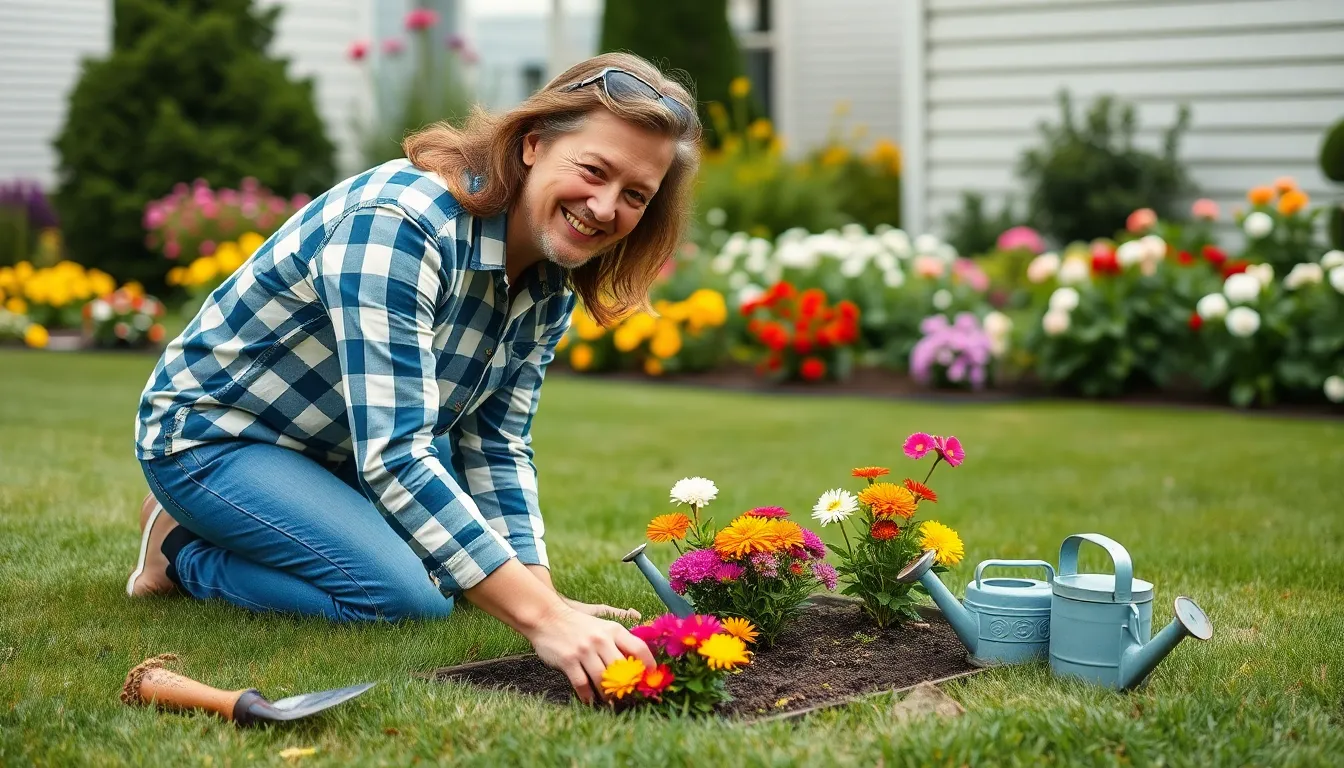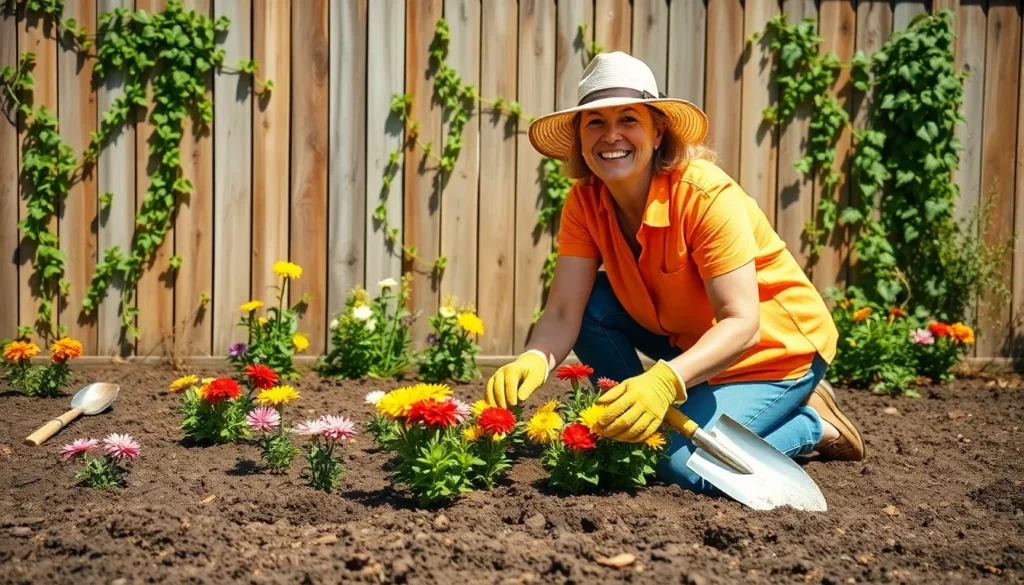Table of Contents
ToggleTransforming your yard into a stunning oasis doesn’t have to cost a fortune or require a degree in landscape architecture. With a little creativity and some elbow grease, anyone can tackle landscaping DIY projects that’ll make neighbors green with envy. Imagine sipping iced tea in your beautifully manicured garden while they wonder if you hired a professional—spoiler alert: you didn’t!
What Is Landscaping DIY?
Landscaping DIY involves creating and maintaining outdoor spaces without hiring professionals. Individuals engage in DIY tasks such as planting flowers, designing hardscapes, and building garden structures. This approach enables homeowners to tailor their landscapes to personal tastes at lower costs.
Many people find satisfaction in transforming their yards through DIY landscaping. It includes various projects like installing pathways, creating flower beds, and adding water features. These activities allow for creativity and hands-on involvement, resulting in unique outdoor environments.
DIY landscaping can incorporate both native and non-native plants. Native plants offer environmental benefits, supporting local wildlife and requiring less maintenance. Choosing the right plants ensures year-round beauty and enhances the overall garden.
Planning remains crucial in landscaping DIY. Homeowners benefit from assessing their space and determining what elements to include. Budget constraints often define the types of plants and materials selected for projects.
Tools such as shovels, trowels, and wheelbarrows play an essential role in DIY landscaping. Investing in quality equipment ensures efficiency and longevity in maintaining outdoor spaces. Proper tool selection facilitates better results in landscaping tasks.
Ultimately, landscaping DIY empowers individuals to create their ideal outdoor sanctuary. With creativity and effort, anyone can achieve impressive landscapes, enhancing property value and enjoyment.
Benefits of Landscaping DIY

Landscaping DIY offers numerous advantages that appeal to homeowners looking to enhance their outdoor spaces.
Cost-Effectiveness
Cost-effectiveness stands out as a key benefit of landscaping DIY. Homeowners save significantly by forgoing professional services, often cutting expenses by 50% or more. Knowing the budget beforehand enhances planning, enabling the selection of materials that fit within financial limits. Many projects, such as planting gardens or building patio structures, utilize affordable materials like mulch and repurposed wood. Furthermore, DIY landscaping minimizes labor costs, allowing individuals to invest their own time and skills instead of hiring outside help.
Personalization
Personalization caters to individual tastes and styles in landscaping DIY. Every design choice reflects the homeowner’s unique vision and preferences. Colors, plant types, and layout configurations become opportunities for self-expression. For instance, creating a butterfly garden with specific plants tailors the landscape to attract wildlife and enhances beauty. This customization allows ongoing adjustments and improvements, ensuring the outdoor space remains dynamic and aligned with changing tastes. As a result, each project becomes a true extension of the homeowner’s personality.
Essential Tools and Materials
Having the right tools and materials makes a significant difference in landscaping DIY projects. Quality equipment ensures efficiency and better results.
Basic Tools for Beginners
Shovels and trowels stand as essential tools for digging and planting. Rakes help level and smooth soil, while pruners assist in shaping plants. A garden hoe allows for easy weed removal. Wheelbarrows simplify transporting soil, plants, and materials. Gloves provide protection during work. These basic tools enable beginners to tackle various landscaping tasks effectively.
Recommended Materials
Soil amendments, such as compost and mulch, improve soil quality. Native plants enhance local biodiversity and require less maintenance. When selecting hardscape materials, consider stone, gravel, or pavers for pathways. Edging materials help define garden beds and create clean lines. Fertilizers promote healthy plant growth and support overall landscaping efforts. Choosing quality materials leads to a more sustainable and visually appealing outdoor space.
Step-by-Step Guide to a Successful Landscaping DIY Project
This guide outlines essential steps for successful DIY landscaping projects. Follow the steps carefully to achieve your desired outdoor transformation.
Planning Your Landscape Design
Begin by assessing the space available in your yard. Understand the unique characteristics of the area, such as sunlight and drainage patterns. Set a clear budget that outlines what you can afford for plants, materials, and tools. Create a design that reflects your personal style, utilizing online tools or sketching on paper. Incorporate native plants to enhance biodiversity and reduce maintenance. Consider including hardscape features like pathways and patios to enhance functionality. Finalize your plan by documenting measurements and layouts for clarity in execution.
Executing Your Design
Start by gathering all necessary materials and tools identified in the planning stage. Preparation of the site typically involves removing weeds and debris for a clean slate. Digging may come next, allowing for planting beds or installation of hardscape features. Follow your design layout precisely, placing plants and features according to your plan. Ensure proper spacing for plant growth by referring to guidelines specific to each species. Apply mulch to conserve moisture and suppress weeds once planting is complete. Take time to continuously assess progress, making adjustments as needed to achieve the desired result.
Common Landscaping DIY Mistakes to Avoid
Selecting the right plants is essential. Choosing plants unsuitable for the local climate results in poor growth or death. Many homeowners underestimate the importance of researching plant requirements, such as sunlight and water.
Ignoring soil quality often leads to issues. Poor soil conditions can affect drainage and nutrient levels. Testing the soil helps determine if amendments are necessary for healthy plant growth.
Overlooking design principles can create disjointed landscapes. A well-planned layout ensures harmony and balance within the yard. Homeowners should consider proportion, color, and scale when designing their spaces.
Neglecting proper plant spacing is another common mistake. Crowded plants may compete for nutrients, leading to unhealthy growth. Maintaining sufficient space between plants fosters better airflow and allows for optimal growth.
Failing to prepare the site adequately can hinder project success. Clearing debris, leveling the ground, and ensuring proper drainage are crucial steps. A well-prepared site contributes to a thriving landscape.
Rushing through the execution phase can lead to costly errors. Carefully following the design plan helps avoid mistakes that may require expensive corrections. Patience during installation proves beneficial in the long run.
Using low-quality tools impacts efficiency and results. Investing in reliable tools such as trowels and pruners enhances the overall experience. Quality tools ensure tasks are completed correctly and efficiently.
Underestimating maintenance needs is a frequent oversight. Regular care such as watering, pest control, and pruning is essential for long-term success. Recognizing ongoing maintenance contributes to sustaining a beautiful landscape.
Landscaping DIY opens up a world of possibilities for homeowners eager to enhance their outdoor spaces. By embracing creativity and careful planning, anyone can create a stunning landscape that reflects their personal style. The journey of transforming a yard into a beautiful oasis not only boosts curb appeal but also fosters a deeper connection with nature.
With the right tools and materials, along with a bit of patience, achieving impressive results is within reach. Avoiding common pitfalls ensures a smoother process and a thriving landscape. Ultimately, DIY landscaping empowers individuals to take control of their environment, creating a unique sanctuary that brings joy and satisfaction for years to come.




